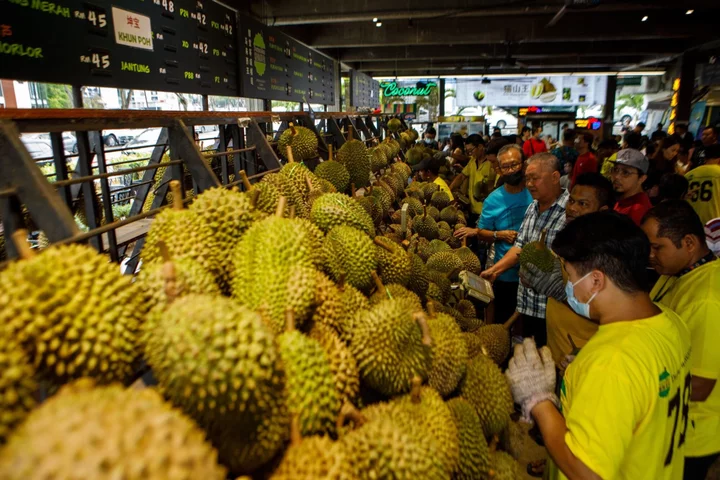Singaporeans love durians. And this year, the spiky and pungent fruit is in such abundance that it can be found in claw machines, giving enthusiasts a chance to catch one for just a dollar.
A surplus in major producer Malaysia has pushed prices in the city-state down to levels never seen before. Even with demand staying high, premium varieties like Musang King were selling for as cheap as S$3 ($2.24) a kilogram earlier this month.
“This is the lowest price I’ve ever seen,” said Sam Tan, executive director of MAPC Sdn. Bhd., a major durian supplier. “Typically, a Musang King will go at S$12 to S$13 per kilogram,” said Tan, who’s also president of the Malaysia Durian Exporters Association and has been in the industry for 12 years.
Farmers in Malaysia, which supplies more than 85% of Singapore’s durians, have been diversifying into the fruit since 2016 as prices jumped, instead of growing traditional crops like palm oil and rubber. Durian trees take at least five to seven years to start producing, contributing to the bountiful harvest this year.
A record-breaking heat wave earlier this year has also affected the quality of the fruit, helping to push prices lower. That’s all good news for durian enthusiasts in Singapore, which imports more than 100,000 kilograms of the fruit a day from Malaysia in peak season.
It isn’t just Malaysia ramping up output, however. Farmers in Thailand and Vietnam have also switched to durians from crops such as rubber and coffee.
Their main target customer is China, where the durian is rapidly becoming the most popular imported fruit.
Read more: Malaysian ‘Designer Durians’ Are Carving Out Niche in China
The surge in investment in Malaysia was driven by booming Chinese demand, according to Lim Chin Khee, a durian consultant based in Pahang who has spent more than two decades in the industry. He blames quality issues for the drop in prices this year.
Hot and dry weather has resulted in 50% to 60% of the durians developing burnt seeds and having less “meat,” MAPC’s Tan said.
With their creamy, custard-like texture, musky flavor and an aroma so strong they’re banned on public transport in many Southeast Asian countries, durians have something of a cult-like following.
Singaporean durian fan Melissa Yap, 55, said she and her husband have been eating the fruit up to three times a week due to the cheap prices. “We are really happy that durians are more affordable now and will certainly be eating more in the coming weeks.”
--With assistance from Anuradha Raghu and Stephen Stapczynski.

